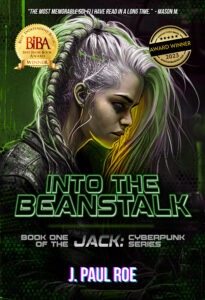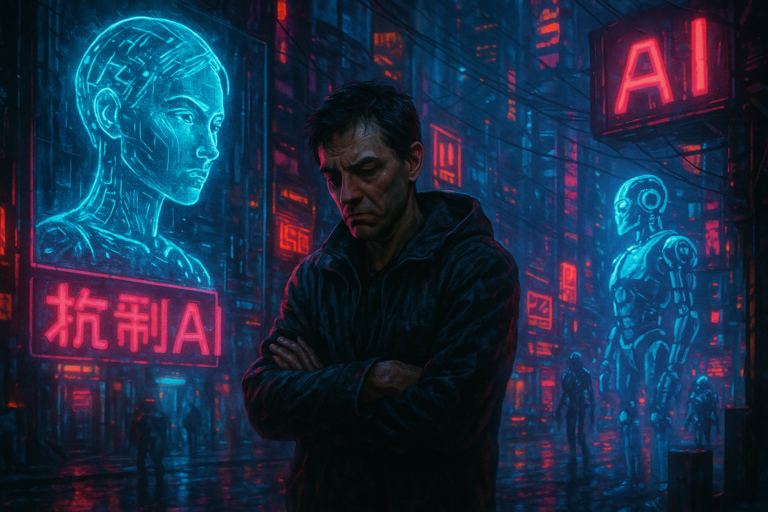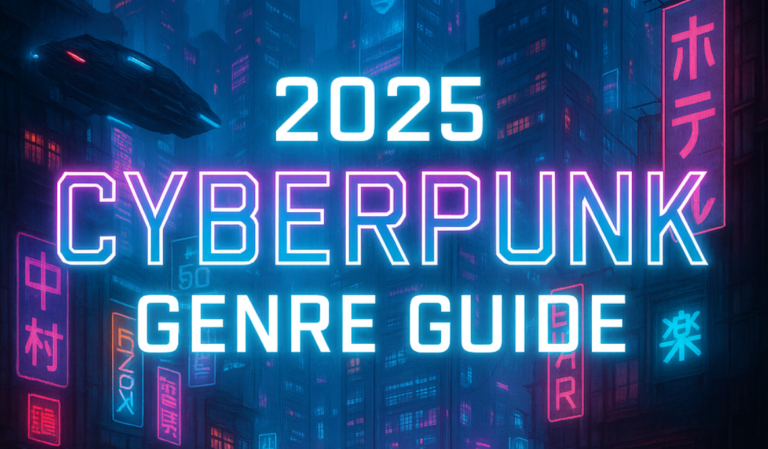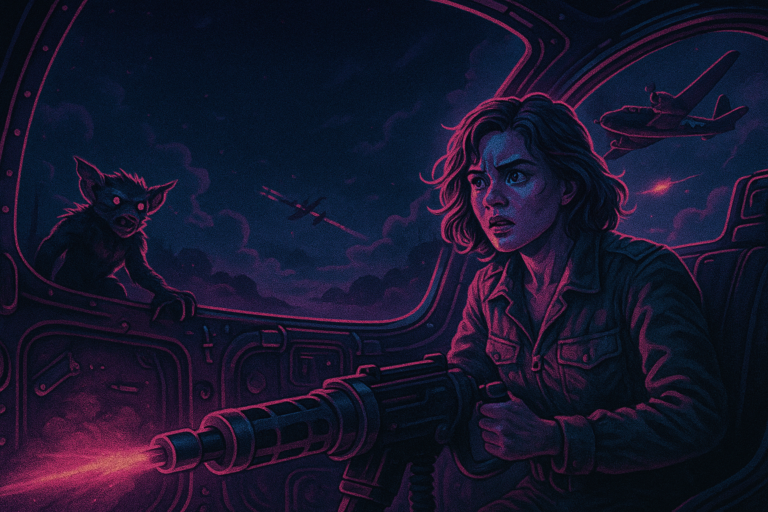Neon-lit streets reflecting in puddles of rain. Hackers diving into virtual realities while corporate skyscrapers loom overhead. Cybernetic implants and rogue AIs challenging what it means to be human.
Welcome to cyberpunk — a literary genre that emerged in the 1980s and continues to captivate readers with its gritty fusion of high technology and low life. Whether you’re drawn to its dystopian futures, its exploration of humanity’s relationship with technology, or simply its unmistakable aesthetic, cyberpunk offers a thrilling literary journey.
But with decades of novels and stories to choose from, where should you begin? This guide will walk you through the essential cyberpunk reads that have defined the genre and serve as perfect entry points for newcomers ready to jack in to these digital worlds.
What’s in this article
What is Cyberpunk?
Cyberpunk stands at the intersection of science fiction and noir, characterized by its “high tech, low life” ethos that explores dystopian futures where advanced technology coexists with societal breakdown. As a literary movement, cyberpunk emerged in the early 1980s as a rebellious response to the optimistic science fiction that dominated previous decades. Instead of starships and alien diplomacy, cyberpunk authors like William Gibson and Bruce Sterling envisioned near-future worlds where megacorporations wield more power than governments, the gap between rich and poor has reached catastrophic proportions, and individuals navigate hostile urban landscapes enhanced (or perhaps imprisoned) by digital technology.
At its core, cyberpunk literature examines how technology transforms — and often deforms — the human experience. The genre typically features marginalized protagonists: hackers, street hustlers, mercenaries, and outcasts who live on society’s fringes, using their technological savvy to survive in environments designed to crush them. Recurring themes include the blurring boundaries between human and machine, virtual and physical reality, and the commodification of both body and mind.
The influence of cyberpunk extends far beyond literature. CD Projekt Red’s game “Cyberpunk 2077” brings players into Night City, a megalopolis that embodies many of the genre’s visual and thematic touchstones, from its neon-saturated streets to the promise of technological transcendence at a steep personal cost. Similarly, “Deus Ex” explores transhumanism and conspiracy through its augmented protagonist in ways that echo classic cyberpunk narratives.
Television has also embraced cyberpunk’s aesthetic and concerns. “Altered Carbon” adapts Richard K. Morgan’s novel about a future where consciousness can be transferred between bodies, examining the social inequalities that would inevitably emerge from such technology. “Mr. Robot” brings cyberpunk sensibilities into contemporary settings, following hackers attempting to bring down corrupt corporate systems. Even “Black Mirror” could be considered cyberpunk’s spiritual successor, exploring how near-future technologies might warp our social fabric.
What distinguishes cyberpunk from other science fiction is its street-level perspective and its distrust of technological progress as inherently beneficial. While traditional sci-fi might celebrate technological advancement, cyberpunk questions who controls that technology, who profits from it, and who suffers because of it — concerns that are increasingly relevant in 2025.
Back to its roots: Top classic cyberpunk books
 1. Neuromancer by William Gibson (1984)
1. Neuromancer by William Gibson (1984)
Blurb: Case was the sharpest data-thief in the Matrix, until he double-crossed the wrong people who damaged his nervous system, leaving him unable to access cyberspace. Now a mysterious employer offers a cure in exchange for one last job: breaking into a seemingly impenetrable artificial intelligence owned by a powerful family dynasty. With the help of Molly, a “razorgirl” with mirrored eyes and lethal reflexes, Case embarks on a journey that will change humanity’s relationship with technology forever.
Influence on Culture: It’s impossible to overstate Neuromancer’s impact—this is the novel that coined the term “cyberspace” and predicted the internet before most people had ever used a computer. Gibson’s vision of a global information network that users could mentally “jack into” presaged virtual reality, online culture, and even elements of social media. The novel won science fiction’s triple crown (the Hugo, Nebula, and Philip K. Dick awards) and established cyberpunk as a legitimate literary movement rather than a passing trend.
Adaptations: Despite numerous attempts, Neuromancer has yet to receive a definitive film adaptation, though its DNA is visible in countless movies and shows. A graphic novel adaptation was released in 1989, and there have been radio drama versions as well.
Why You Should Read It: This is where cyberpunk truly begins. Gibson’s prose is electric — a fusion of noir aesthetics, street slang, and technical jargon that creates an immersive and disorienting experience. Reading Neuromancer is like being dropped into a foreign country where you gradually piece together the language and customs. Its influence on how we conceptualize the digital world makes it not just important science fiction but important literature.
 2. Do Androids Dream of Electric Sheep? by Philip K. Dick (1968)
2. Do Androids Dream of Electric Sheep? by Philip K. Dick (1968)
Blurb: In a post-apocalyptic 2021, Rick Deckard works as a bounty hunter tasked with “retiring” escaped androids who have fled to Earth from Mars colonies. As Deckard hunts down a group of advanced Nexus-6 models nearly indistinguishable from humans, he begins to question the nature of empathy, identity, and what it truly means to be human. Meanwhile, most real animals have died out, leaving humans to care for electric replacements as status symbols and sources of emotional connection.
Influence on Culture: While published before cyberpunk crystallized as a genre, Dick’s novel laid crucial groundwork with its exploration of artificial intelligence, corporate power, and posthuman identity. Its influence extends beyond science fiction into philosophy and ethics, particularly regarding consciousness and artificial beings. The book’s concerns about empathy in a technologically-mediated world remain startlingly relevant.
Adaptations: Most famously adapted into Ridley Scott’s 1982 film Blade Runner, which, while diverging significantly from the source material, became a defining visual template for cyberpunk aesthetics with its rain-soaked neon cityscapes. The 2017 sequel Blade Runner 2049 further expanded this universe. A comic series has also been published.
Why You Should Read It: While Blade Runner defined cyberpunk’s look, the novel offers deeper philosophical exploration. Dick’s examination of what constitutes humanity when consciousness can be manufactured feels increasingly urgent in our era of advancing AI. The book’s environmental themes—particularly the longing for connection with the natural world—also provide a dimension often overlooked in discussions of cyberpunk. The novel’s paranoid atmosphere and questions about reality make it a perfect introduction to Dick’s unique worldview.
 3. Snow Crash by Neal Stephenson (1992)
3. Snow Crash by Neal Stephenson (1992)
Blurb: In a hyper-capitalist future America where corporations have replaced government, Hiro Protagonist works as a pizza deliveryman in the real world and a renowned swordsman in the Metaverse — a virtual reality successor to the internet. When he encounters a new drug called Snow Crash that can affect users both online and offline, Hiro finds himself drawn into a conspiracy involving ancient Sumerian linguistics, memetic viruses, and the very foundation of human consciousness.
Influence on Culture: Snow Crash popularized the term “Metaverse” and predicted many aspects of online virtual worlds years before Second Life or World of Warcraft. The novel’s vision of a privatized America divided into corporate “burbclaves” provided a satirical but prescient look at growing inequality and corporate power. Silicon Valley entrepreneurs have cited the book as inspiration, with its concepts influencing virtual reality development.
Adaptations: Amazon had been developing a TV series adaptation with Joe Cornish attached as director, though its current status is uncertain. The book’s visual style and concepts have influenced numerous video games, including the MMO culture it effectively predicted.
Why You Should Read It: Snow Crash represents cyberpunk’s second wave — more self-aware, more satirical, and often more fun than its predecessors. Stephenson blends breathless action sequences with deep dives into linguistics, ancient mythology, and information theory. His world-building is expansive and detailed, with memorable concepts like the aircraft carrier turned refugee settlement “The Raft” and the cyborg “Rat Things.” For readers who find earlier cyberpunk too bleak or stylistically challenging, Snow Crash offers an accessible entry point without sacrificing intellectual depth.
 4. Count Zero by William Gibson (1986)
4. Count Zero by William Gibson (1986)
Blurb: Seven years after the events of Neuromancer, the matrix has changed. Turner, a mercenary corporate extractionist, is hired to help a gifted scientist defect from one megacorporation to another. Bobby Newmark, a young would-be hacker calling himself “Count Zero,” nearly dies on his first illicit trip into cyberspace when he attracts mysterious entities. And Marly Krushkhova, an art dealer, is recruited by a reclusive billionaire to track down the creator of a series of peculiar art pieces. As their stories converge, they discover artificial intelligences have fragmented into “voodoo gods” that roam cyberspace.
Influence on Culture: While less recognized than its predecessor, Count Zero deepened the cyberpunk canon by introducing religious and mystical elements into its technological framework. The novel’s concept of AIs manifesting as Haitian loa (spirits) presaged later explorations of how different cultures might interpret and interact with advanced technology. Its multi-narrative structure became a common approach in cyberpunk storytelling.
Adaptations: Like Neuromancer, Count Zero has not been directly adapted for screen, though its thematic exploration of artificial intelligences developing god-like capabilities has influenced numerous works, including the TV series Person of Interest.
Why You Should Read It: Count Zero demonstrates cyberpunk’s versatility, showing how the genre can incorporate elements of different cultures and belief systems. Gibson’s second Sprawl novel is more accessible than Neuromancer while maintaining the electric prose style that made him famous. The book excels at contrasting the lives of its three protagonists—from corporate luxury to street-level survival—providing a comprehensive view of its stratified society. It’s also a perfect example of how cyberpunk can function as a noir mystery, with characters gradually uncovering the truth behind seemingly unconnected events.
 5. Burning Chrome by William Gibson (1986)
5. Burning Chrome by William Gibson (1986)
Blurb: This collection of Gibson’s early short stories includes the titular “Burning Chrome,” which introduced many elements later expanded in Neuromancer, as well as “Johnny Mnemonic” and “New Rose Hotel.” These stories explore everything from data traffickers with information stored directly in their brains to corporate extraction specialists to hackers targeting powerful criminal enterprises.
Influence on Culture: These stories, many published before Neuromancer, helped establish cyberpunk’s foundational tropes and aesthetic. “Burning Chrome” introduced the term “cyberspace,” while other stories pioneered concepts like wetware (biological computer components) and various forms of human augmentation. The collection demonstrates how Gibson pulled from noir fiction, drug culture, and punk rock to create cyberpunk’s distinctive voice.
Adaptations: “Johnny Mnemonic” was adapted into a 1995 film starring Keanu Reeves, which, despite its commercial failure, has become a cult classic representative of 1990s cyberpunk aesthetics. “New Rose Hotel” became a 1998 film directed by Abel Ferrara starring Christopher Walken, Willem Dafoe, and Asia Argento.
Why You Should Read It: Short stories provide an excellent entry point into cyberpunk for readers intimidated by novel-length commitments. These stories distill cyberpunk to its essence: the desperate interface between humanity and technology in a world dominated by corporate power. The collection also reveals Gibson’s skill at creating memorable characters and settings with remarkable economy. Reading “Burning Chrome” before Neuromancer provides helpful context, as many ideas are introduced here in more accessible forms before being developed in the novels.
The New Wave: Top modern cyberpunk books
 1. Altered Carbon by Richard K. Morgan (2002)
1. Altered Carbon by Richard K. Morgan (2002)
Blurb: In a future where human consciousness can be stored digitally and downloaded into new bodies (called “sleeves”), Takeshi Kovacs, a former elite soldier turned criminal, is brought out of prison storage to investigate the apparent suicide of a wealthy man. The catch: the wealthy man himself hired Kovacs, believing he was murdered. As Kovacs navigates a world where the rich can live forever by transferring their consciousness to new bodies while the poor make do with whatever sleeves they can afford, he uncovers conspiracies that span centuries.
Influence on Culture: Morgan’s novel revitalized cyberpunk for the 21st century, shifting focus from virtual reality to questions of mind/body dualism, digital consciousness, and extreme social inequality enabled by technology. The book’s unflinching examination of how immortality technology would inevitably create new forms of class division has influenced discussions about transhumanism and technological ethics.
Adaptations: Netflix adapted Altered Carbon into a high-budget series that ran for two seasons (2018-2020), starring Joel Kinnaman and later Anthony Mackie as different “sleeves” for the protagonist. A cyberpunk anime film set in the same universe, Altered Carbon: Resleeved, was also released on Netflix in 2020.
Why You Should Read It: Altered Carbon perfectly updates cyberpunk for the modern era while remaining true to the genre’s roots. Morgan combines hard-boiled detective fiction with visceral action sequences and thoughtful exploration of how technology might reshape humanity’s relationship with mortality, identity, and embodiment. The novel pulls no punches in its depiction of violence and sexuality, creating a raw, immersive experience that captures the gritty essence of cyberpunk.
 2. Infomocracy by Malka Older (2016)
2. Infomocracy by Malka Older (2016)
Blurb: In a world where traditional nation-states have been replaced by “micro-democracies” of 100,000 people each, global elections are managed by Information, a powerful search engine organization that has transformed into something between a public utility and a surveillance apparatus. As the third worldwide election approaches, a researcher, a political operative, and an Information security analyst find themselves caught in a web of conspiracies that threaten to undermine the entire system as they know it.
Influence on Culture: Older’s “political cyberpunk” novel arrived at a time when concerns about social media’s influence on democracy, data privacy, and information warfare were becoming mainstream conversations. The book’s exploration of how technology might reshape governance has made it a touchstone in discussions about digital democracy and the future of the nation-state in an interconnected world.
Adaptations: While not yet adapted for screen, Infomocracy’s unique vision of future governance has been featured in academic discussions and political science courses examining the intersection of technology and democracy.
Why You Should Read It: Infomocracy expands cyberpunk’s horizons by focusing less on street-level hackers and more on the systemic implications of information technology on global politics. Older, who has worked in humanitarian aid and disaster management, brings real-world insight into how information flows shape power structures. The novel offers a fascinatingly ambiguous take on whether its micro-democracy system represents a utopian or dystopian development—a refreshing nuance in a genre often tilted toward the dystopian.
 3. Into the BeanStalk by J. Paul Roe (2024)
3. Into the BeanStalk by J. Paul Roe (2024)
Blurb: Jack is a techie who resorts to working with a powerful biker gang to pay for much-needed replacement limbs. After a state-sponsored cyberattack against the criminal organization goes awry, a strange new power is unlocked in her bioneural hardware: she can sense a massive pillar of data connecting her home, Hope Megacity, to the city of powerful Founders and their families a mile overhead. By making contacts with rebels and outcasts from every walk of life, Jack learns to understand and exploit this new power, leading her to uncover the secrets of her world that have been buried for over a hundred years.
Influence on Culture: Roe’s debut cyberpunk novel explores the genre in an updated fashion that’s relevant to readers in the 2020s. Breaking away from the 1980s tropes, this timely novel explores a world where tech billionaires created sovereign states in the face of crumbling governments and diminished faith in traditional systems of power. In technocracies where privacy is all but eliminated and citizens are ranked by their value to the state, the most valuable commodity is hope — a sentiment that has been actively farmed and manipulated by corporations for over a century.
Adaptations: As of early 2025, Into the BeanStalk is being adapted into a full cast audio drama through a media partnership with Arcane Fiction. The book is also being adapted into a motion comic later this year. Roe leaked that a tabletop RPG game was in development, as well as AR/VR supported versions of the story through collaborations with well-known artists and software developers.
Why You Should Read It: Into the BeanStalk updates classic cyberpunk concepts for the era of social media, targeted advertising, and data mining. Roe’s protagonist represents a new type of cyberpunk hero — technically brilliant but also emotionally complex, navigating both digital and social connections. Breaking away from the typical “gangs and Japanese corporation” tropes, ITBS explores neo-cyberpunk through deep worldbuilding and engaging characters.
 4. Autonomous by Annalee Newitz (2017)
4. Autonomous by Annalee Newitz (2017)
Blurb: In 2144, Jack Chen is a pharmaceutical pirate who reverse-engineers patented drugs to provide affordable medication to those who need it. After one of her drug hacks causes unexpected fatal reactions, Jack embarks on a mission to fix her mistake, pursued by Eliasz, a military agent, and his robot partner Paladin. As the chase unfolds across a world where both humans and machines struggle with questions of freedom and autonomy, Paladin begins questioning its own programming and developing feelings for Eliasz.
Influence on Culture: Newitz’s novel expanded cyberpunk’s scope to incorporate biotechnology, pharmaceutical politics, and AI rights. The book’s exploration of patent law and intellectual property in a post-scarcity world has resonated with growing real-world concerns about medicine access and corporate control of lifesaving technologies.
Adaptations: While no screen adaptation has been announced, Autonomous has been optioned for development. The novel has received widespread critical acclaim, winning the Lambda Literary Award.
Why You Should Read It: Autonomous refreshes cyberpunk by shifting focus from information technology to biotechnology while maintaining the genre’s concern with corporate power and human freedom. Newitz, a science journalist, brings technical credibility to both the biotech and AI elements of the story. The novel is particularly notable for its nuanced exploration of robot consciousness and its complex take on sexuality and gender, including one of the more thoughtful explorations of robot sexuality in contemporary science fiction. The alternating perspectives between Jack and Paladin provide a comprehensive view of this future society from both human and artificial viewpoints.
 5. The Water Knife by Paolo Bacigalupi (2015)
5. The Water Knife by Paolo Bacigalupi (2015)
Blurb: In a near-future American Southwest devastated by climate change and drought, states battle over dwindling water resources from the Colorado River. Angel Velasquez works as a “water knife”—an operative who “cuts” water supplies from one location to another through sabotage, bribery, and violence on behalf of drought-resistant arcologies in Las Vegas. When he’s sent to Phoenix to investigate rumors of a new water source, Angel becomes entangled with Lucy, a journalist, and Maria, a young refugee, in a deadly struggle over water rights that could reshape the entire region.
Influence on Culture: Bacigalupi’s eco-cyberpunk novel arrived as climate change concerns were becoming increasingly mainstream. The book has been cited in discussions about water rights, climate refugees, and infrastructure resilience. Its vision of climate-ravaged America has influenced how we imagine near-future environmental collapse scenarios.
Adaptations: While not yet adapted for screen, The Water Knife has been optioned for development. The novel’s vivid imagery and action sequences make it a natural candidate for visual adaptation.
Why You Should Read It: The Water Knife demonstrates how cyberpunk can evolve to address contemporary concerns while maintaining genre touchstones like corporate power, advanced technology, and noir-influenced storytelling. Bacigalupi combines pulse-pounding action with meticulous world-building, creating a future that feels disturbingly plausible. The novel’s focus on water—rather than data or digital technology—as the most precious resource provides a fresh take on cyberpunk themes of resource control and inequality. The book also excels at depicting the lived reality of climate disruption, from dust storms and heat waves to refugee crises and failed states, making abstract climate concerns visceral and immediate.







